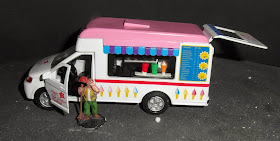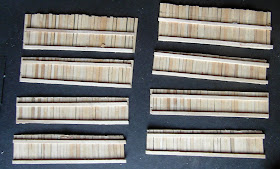So having posted last week about the first of the two doll houses I converted last week, here's the second one alongside the first.
The actual process of converting the second was identical to the first, more or less to the first though I had learned some lessons with what to cut and what not to.
 |
| Front of house #2 |
Here's house#2 alongside the original model. The front of this building is the back of the other and vice-verse. This house would have a picket fence surrounding it on three sides rather than having to add a larger base as I did in house#1.

This side of the building was flush with the base so required no fencing, but the obvious disparity between the two walls had to be fixed with a small piece of card, it was then covered in filler and the planking was scribed to it - not as complete a success as I would have liked but nevertheless sufficient for my purposes.
 |
| Rear of house #2 (front of house#1), with added fences |
The fence that came with the model was a tad twee so I added my own, stuck straight to the base and then it had a "base" of a filler added for strength and aesthetic reasons. (the fence would otherwise have looked far too huge)
 |
| Side with "garden" |
|
The final side of the house had the same problem of aligning the walls, but with the added complication of the arched window, again a thin piece of card sorted the problem.
The side "path" was unusable to place figures on once the picket fencing was in place, even for my slim 20mm bases, so I put a few bits of vegetation in to deter players from attempting to place figures there.
Notice the absence of any chimneys on this one.
 |
| Boring close up shot. |
A couple of very old hedge pieces and some sisal topped off with two variations of flock I thought was sufficient to complete this bit.
The picket fencing is of course coffee stirrers which I had already made some time ago, though it should be obvious that I didn't take too much care with the heights of the individual pieces.

Moving on to the internals then, here's the top floor of house#1 .
There isn't a lot of space to really do anything here other than the basics so it's very minimalist.
The floor is "lift out", but the few bits that are there are all glued in place.
I did take care not to block the window areas (even those in the bathroom that were integral to the roof) so as to allow figures to 'use' them.
The internal doors of both models don't open and are in fact the centre of a triple layer of thin card with frames attached.
 |
| bathroom |
I used two pieces that came with the original models for the bathroom fixtures, but I did raise the toilet onto a small bit of scrap plastic tubing, nothing fancy really.
The stairwell and corridor is made up of scraps of card whilst a piece of bamboo skewer served as a the top of the rail.
Door handles are slivers off coffee stirrers.
With so little space to get much detail in I opted just for the bed on the wall (but note that it's not immediately up against the wall, to allow for the floor to be removed).
 |
| View of downstairs |
Downstairs can be seen the general layout the both houses follow, kitchen to one side and living room type area on the other.
The staircase has by necessity had to be places in the centre of the
building, the eaves of the roof and window placing allowing little place
else to go.
 |
| Living area |
The sofa came from my 'stock' of scratchbuilt ones , whilst the bookshelf came with the models.
The carpet is paper and the only other additions are a book and a newspaper, both scratch-built additions.
You will have no doubt noticed the many flecks of white all over these
models, caused by paint constantly flaking off the walls.
It doesn't bother me that
much and I reckon it's
just something I can put up.
 |
| Half the kitchen |
 |
| Other half, with oven |
Two views of the kitchen area 'halves', I did two very similar models for the two houses at the same time.
Two pieces of foamboard and thin card, topped with slivers of wood for the handles.
I could have gone for a lot more detail but didn't think it worth the effort.
The floor tiles are a paper sheet coloured with a wash of paint (like the bathroom.
 |
| Top floor of house#2 |
The second house, as can be seen, follows almost the exact design of the first.
I have added a washbasin to the bathroom and the bath is a scratchbuilt one I made from foamboard.
 |
| Boring Bathroom |
All details for the bathroom follow the exact lines of the first build.
 |
| Upstairs landing |
|
|
|
 |
| Bedroom | |

The downstairs of house#2 follows the same lines as the first, but with even less furniture.
The telephone by the front door came from one of the original models, as did the long side table, whilst the single armchair and kitchen area were all scrathbuilt as above.
The carpet is of course paper.
 |
| Living room area |
 |
| Telephone detail and opening door ! |
|
| |
|
|
 |
| Kitchen area |
General view of the kitchen area and note the copious amounts of stray flock on the stairs (I'm thinking that there may be a static element to the plastic attracting the flock)
And that as they say is that, but I would like you to leave with this photograph of my £2 house alongside the commercial "American farmstead" that cost me £15.
The footprint of the dolls houses, excluding the surrounding base is about 6" x 4.5" (150mm x 115mm), about the same as the farmstead; the height to the roof ridge is about 4'5"
That's it then for another week and as always your comments are both welcomed and appreciated.






 "
"




























































